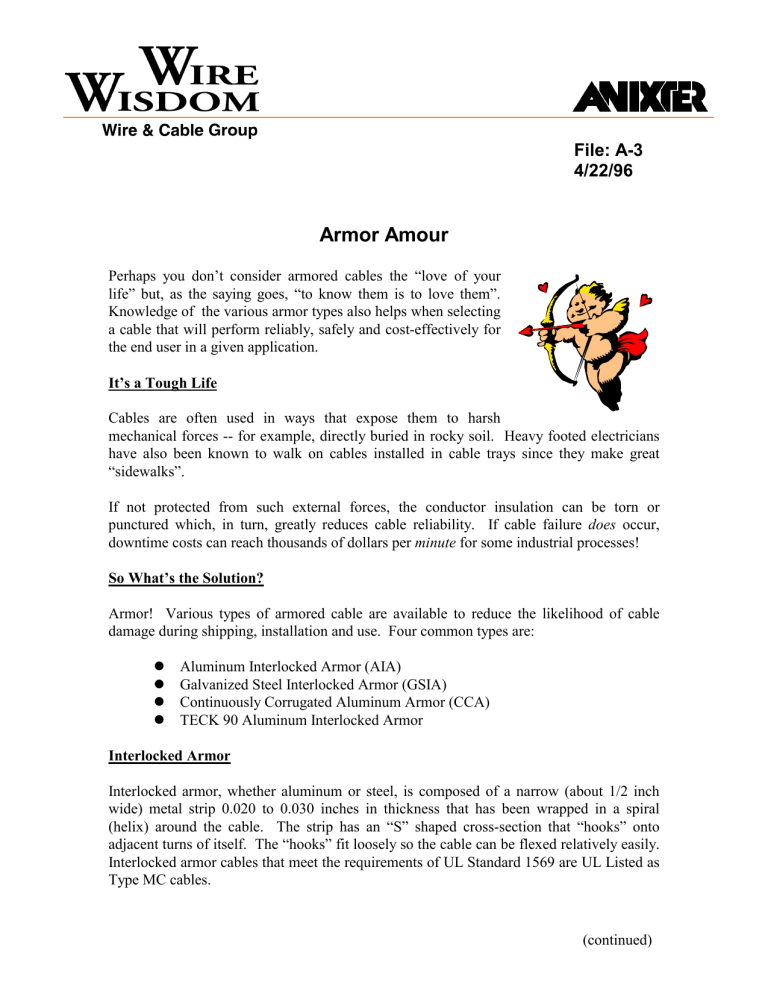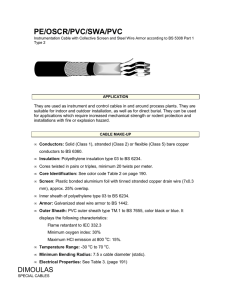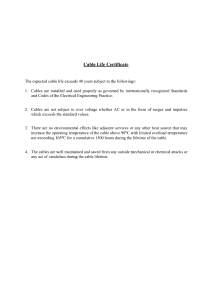
File: A-3 4/22/96 Armor Amour Perhaps you don’t consider armored cables the “love of your life” but, as the saying goes, “to know them is to love them”. Knowledge of the various armor types also helps when selecting a cable that will perform reliably, safely and cost-effectively for the end user in a given application. It’s a Tough Life Cables are often used in ways that expose them to harsh mechanical forces -- for example, directly buried in rocky soil. Heavy footed electricians have also been known to walk on cables installed in cable trays since they make great “sidewalks”. If not protected from such external forces, the conductor insulation can be torn or punctured which, in turn, greatly reduces cable reliability. If cable failure does occur, downtime costs can reach thousands of dollars per minute for some industrial processes! So What’s the Solution? Armor! Various types of armored cable are available to reduce the likelihood of cable damage during shipping, installation and use. Four common types are: Aluminum Interlocked Armor (AIA) Galvanized Steel Interlocked Armor (GSIA) Continuously Corrugated Aluminum Armor (CCA) TECK 90 Aluminum Interlocked Armor Interlocked Armor Interlocked armor, whether aluminum or steel, is composed of a narrow (about 1/2 inch wide) metal strip 0.020 to 0.030 inches in thickness that has been wrapped in a spiral (helix) around the cable. The strip has an “S” shaped cross-section that “hooks” onto adjacent turns of itself. The “hooks” fit loosely so the cable can be flexed relatively easily. Interlocked armor cables that meet the requirements of UL Standard 1569 are UL Listed as Type MC cables. (continued) (A-3 continued) CCA Armor Continuously corrugated aluminum armor, on the other hand, is made of a wide strip of aluminum whose width matches the circumference of the cable. As with interlocked armor, the strip is 0.020 to 0.030 inches in thickness. The wide aluminum strip is longitudinally wrapped around the cable in a manner similar to the way cigarette paper is wrapped around a cigarette, then welded at the seam. This smooth aluminum tube is then rolled to form spiral ridges (corrugations) that allow the cable to be bent without kinking the armor. CCA armored cables that meet the requirements of UL Standard 1569 are UL Listed as Type MC cables. Although higher in cost and more difficult to bend than interlocked armor, CCA armored cables provide a very effective barrier against chemicals and moisture that can shorten cable life. In addition, CCA armor is a very effective barrier (electrical shield) against electromagnetic fields (EMF) that would otherwise radiate from the cable. The shielding function is particularly important for cables being used with pulse width modulated (PWM), variable speed AC drives that are increasingly being used in industrial applications. “Philsheath” is BICC Cable Company’s tradename for their CCA armored cables. TECK 90 Cable TECK 90 is a type of aluminum interlocked armor (AIA) cable that originated and is widely used in Canada. TECK 90 has a PVC jacket under the armor as well as over it. With two jackets, the insulation of a TECK 90 cable is even better protected from external physical and chemical damage than is the insulation of standard interlocked armor cable (UL Type MC) with only one jacket. “Norteck” is Alcatel’s tradename for a TECK 90 cable that meets both US (UL Type MC) and Canadian (CSA Type TECK 90) requirements. A detailed comparison of Norteck’s characteristics with those of a standard AIA cable is given in Wire Wisdom A-4. Now that you have developed an amour with armor -- or at least we hope you have -- keep armored cables in mind for those physically harsh and chemically demanding cable applications. WDW


